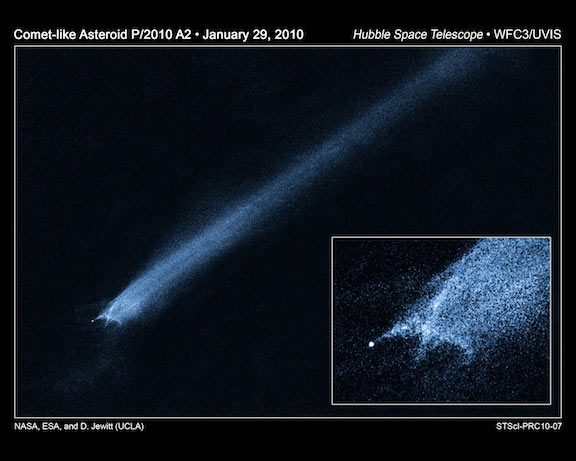Life's Building Blocks Found on Surprising Meteorite

Scientistshave discovered amino acids, the building blocks of life in a meteorite wherenone were expected.
Thefinding adds evidence to the idea that some of life's key ingredients couldhave formed in space, and then been delivered to Earth long ago by meteoriteimpacts.
Themeteorite in question was born in a violent crash, and eventually crashed into northernSudan. [Meteorite craters on Earth]
"Thismeteorite formed when two asteroids collided," said Daniel Glavin of NASA'sGoddard Space Flight Center in Greenbelt, Md. "The shock of the collisionheated it to more than 2,000 degrees Fahrenheit [1,093 degrees Celsius], hotenough that all complex organic molecules like amino acids should have beendestroyed, but we found them anyway."
Aminoacids are the molecules used to build the proteins that are essential to life.
"Findingthem in this type of meteoritesuggests that there is more than one way to make amino acids in space, whichincreases the chance for finding life elsewhere in the universe," Glavinsaid in a statement.
Theproteins created from aminoacids are used in everything from structures like hair to enzymes, thecatalysts that speed up or regulate chemical reactions. Just as the 26 lettersof the alphabet are arranged in limitless combinations to make words, life uses20 different amino acids in a huge variety of arrangements to build millions ofdifferent proteins.
Breaking space news, the latest updates on rocket launches, skywatching events and more!
Inprevious missions, scientists found amino acids in samples of Comet Wild 2, andin various carbon-rich meteorites. Finding amino acids in these objectssupports the theory that the origin of life got a boost from space.
Butwhen Peter Jenniskens of the SETI Institute in Mountain View, Calif., and NASA'sAmes Research Center in Moffett Field, Calif., approached NASA with thesuggestion to search for amino acids in the carbon-rich remnants of asteroid2008 TC3, most scientists expected none to be found.
Becauseof an unusually violent collision in the past, this asteroid'samino acids were scrambled and now mostly in the form of graphite.
Ameteorite sample was divided between the Goddard lab and a lab at the ScrippsInstitution of Oceanography at the University of California, San Diego.
"Ouranalyses confirm those obtained at Goddard," said Jeffrey Bada of Scripps,who led the study there. The extremely sensitive equipment in both labsdetected small amounts of 19 different amino acids in the sample, ranging from0.5 to 149 parts per billion.
Theteam had to be sure that the amino acids in the meteorite didn't come fromcontamination on Earth, and they were able to do so because of the way aminoacids are made. Amino acid molecules can be built in two ways that are mirrorimages of each other, like your hands. Life on Earth uses left-handedamino acids, and they are never mixed with right-handed ones, but the aminoacids found in the meteorite had equal amounts of the left and right-handedvarieties.
Thesample had various minerals that only form under high temperatures, indicatingit was forged in a violent collision. It's possible that the amino acids aresimply leftovers from one of the original asteroids in the collision ? anasteroid that had better conditions for amino acid formation.
JenniferBlank of SETI has done experiments with amino acids in water and ice, showingthey survive pressures and temperatures comparable to a low-angle comet-Earthimpact or asteroid-asteroid collisions.
However,the team thinks it's unlikely amino acids could have survived the conditionsthat created the meteorite, which endured higher temperatures ? more than 2,000degrees Fahrenheit (over 1,100 degrees Celsius) ? over a much longer period.
"Itwould be hard to transfer amino acids from an impactor to another body simply becauseof the high-energy conditions associated with the impact," Bada said.
Instead,the team believes there's an alternate method of creating amino acids in space.
"Previously,we thought the simplest way to make amino acids in an asteroid was at coolertemperatures in the presence of liquid water. This meteorite suggests there'sanother way involving reactions in gases as a very hot asteroid cools down,"Glavin said.
Theteam is planning experiments to test various gas-phase chemical reactions tosee if they generate amino acids.
Fragmentsof 2008 TC3 are collectively called "Almahata Sitta" or "StationSix" after the train stop in northern Sudan near the location where pieceswere recovered. They are prized because they are Ureilites, a rare type ofmeteorite.
"Aninteresting possibility is that Ureilites are thought by some researchers tohave formed in the solar nebula and thus the findings of amino acids inAlmahata Sitta might imply that amino acids were in fact synthesized very earlyin the history of the solar system," Bada said.
Thestudy is detailed in the Dec. 15 edition of the journal Meteoritics andPlanetary Science.
- Gallery - Earth's Meteor Craters
- 5Reasons to Care About Asteroids
- Video - Meteor's Fall Caught on Camera

Space.com is the premier source of space exploration, innovation and astronomy news, chronicling (and celebrating) humanity's ongoing expansion across the final frontier. Originally founded in 1999, Space.com is, and always has been, the passion of writers and editors who are space fans and also trained journalists. Our current news team consists of Editor-in-Chief Tariq Malik; Editor Hanneke Weitering, Senior Space Writer Mike Wall; Senior Writer Meghan Bartels; Senior Writer Chelsea Gohd, Senior Writer Tereza Pultarova and Staff Writer Alexander Cox, focusing on e-commerce. Senior Producer Steve Spaleta oversees our space videos, with Diana Whitcroft as our Social Media Editor.
